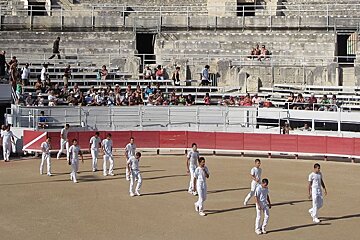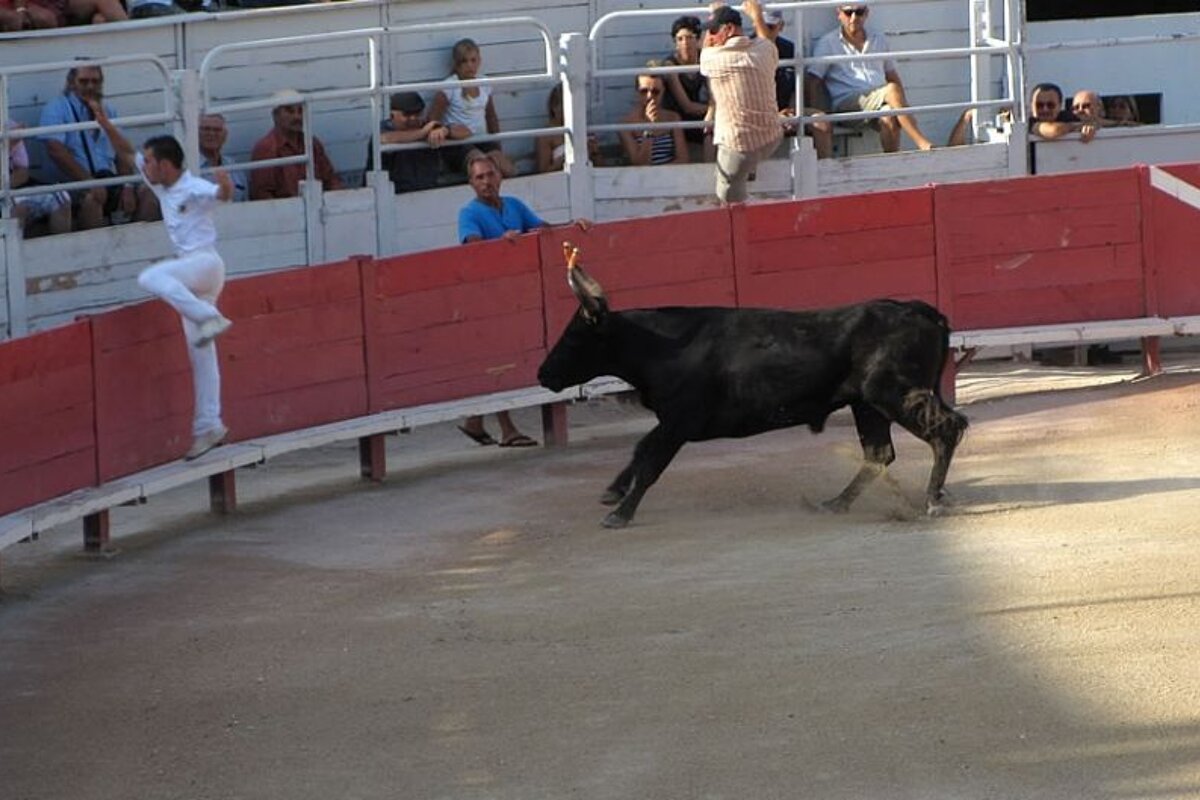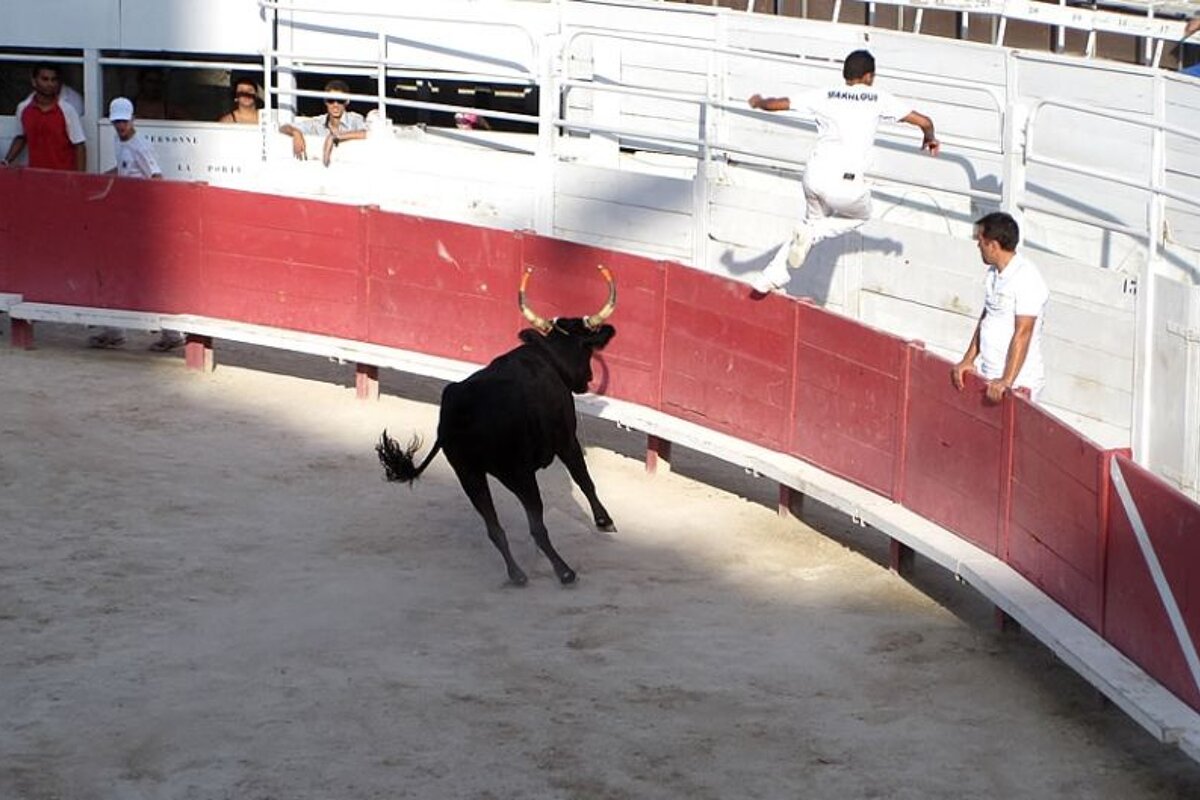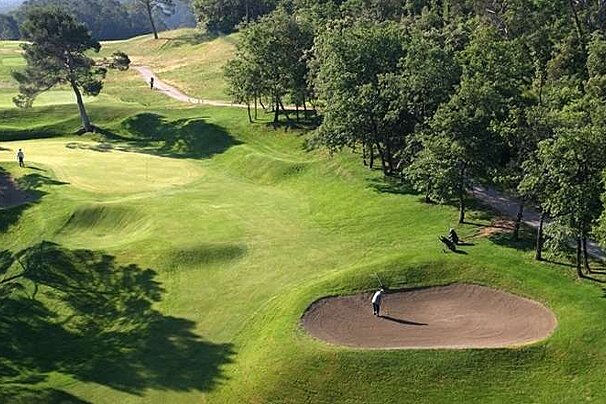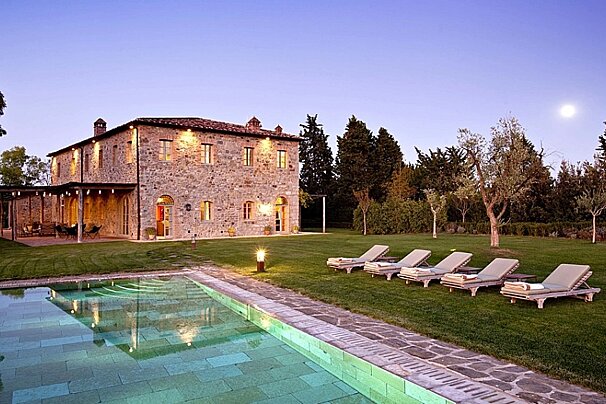
Course Camarguaise
'Bullfighting' without the fighting
The black bull is pawing the ground and bellowing in anger. A man darts past the bull, deftly plucking a tassel from its horns and sprints away. The bull charges across the sandy arena, almost catching the man before he leaps over the head-high barrier to safety. As the bull crashes into the wooden fence behind him, music from Bizet’s Carmen blasts out and the delighted crowd applauds the bull’s spirit and the man’s bravery.
This drama is playing out in Arles’ Roman arena. We are sitting in the blazing August sun on stone seats used two thousand years ago by spectators of other bloodthirsty contests between men and animals. Today’s event, however, involves no blood-shedding. We are watching a “Course Camarguaise”, the French form of bullfighting in which the bull is unharmed and left to fight another day.
The Camargue bulls are a celebrated part of this region’s identity. “Jeu taurin” or “bull game” has a long history in the south east of France: the earliest recorded game in Arles dates back to 1402. The black Camargue bulls are specially bred for their fighting spirit and feature in many events including the running of bulls through the streets at every village fiesta. Corridas, or Spanish-style bullfights in which the bull is killed, are also held here.
We arrive early to secure a seat on the shady side of the arena. Hundreds of tourist and locals are filling up the stone benches, the more organised among them bringing cushions, cold drinks and sunhats. A hawker is selling snacks and I am irresistibly reminded of a scene in the film The Life of Brian. I secretly hope he might be selling larks' tongues, otters' noses and ocelot spleens but sadly, popcorn and crisps are his only wares.
In traditional, laid-back Provencal style, the event begins 20 minutes late but nobody seems to mind. A blast of the Toreador’s song from Carmen heralds the dozen “Razeteurs”, young men dressed in white who will confront the bulls. They take their bows then leave the arena while the real star of the show is ushered in.
He is a young black bull, introduced by his number and the name of the farm which reared him. A seasoned fighter, he is already trotting around the ring searching for opponents. Though he is not as massive as the bulls used in Spanish bullfighting, he is lithe and fast on his feet and quite obviously fierce. I’m glad to note that the tips of his horns are shielded.
A trumpet sounds and the razeteurs vault over the safety barrier and begin the game. The razeteurs’ aim is to remove the various object tied to the bull’s horns in the correct order: a red rosette, white tassels then strings wrapped around the horns, each worth a sum of money. The men are equipped with special combs designed to catch the objects without harming the bull and have only 15 minutes with each of the six bulls.
The men’s bravery (or foolhardiness, depending on your viewpoint) is immediately obvious. Their skill and tactics gradually become apparent. One, the caller, attracts the bull’s attention another makes a run past the bull’s head and then dashes towards the safety barriers surrounding the ring. This they clear with an athletic leap.
Nobody, however, has explained the concept of a safety area to the bull. The first bull jumps the barrier with the ease of a show jumper and causes instant panic. All the hangers-on in the safety area suddenly find themselves in the path of an angry, charging bull and have to leap into the ring.
Eventually, the bull is lured back into the ring using a red rag (and, yes, I’m pleased to see that bulls really do charge a red rag on a stick) and the game recommences.
Two hours go past in a flash. We have watched six bulls and seen only one injury (caused by a miss-timed vault rather than a goring) and feel we’ve had thoroughly good value for our €10 tickets. We all agree the Course Camarguaise is an exciting event and we feel close to the authentic traditions of the region.
Courses Camarguaises are held throughout the summer in Arles Arena every Wednesday and Friday and also in many of the surrounding towns. Details of events can be found in the local press. If you don’t want to watch a Spanish-style bullfight, make sure you avoid events advertised with “mise à mort” or “corrida” in the description.


